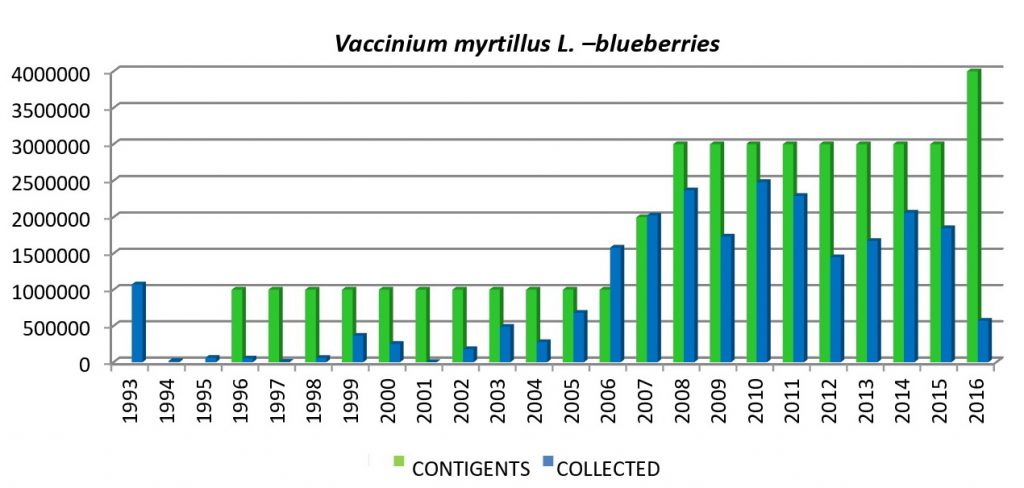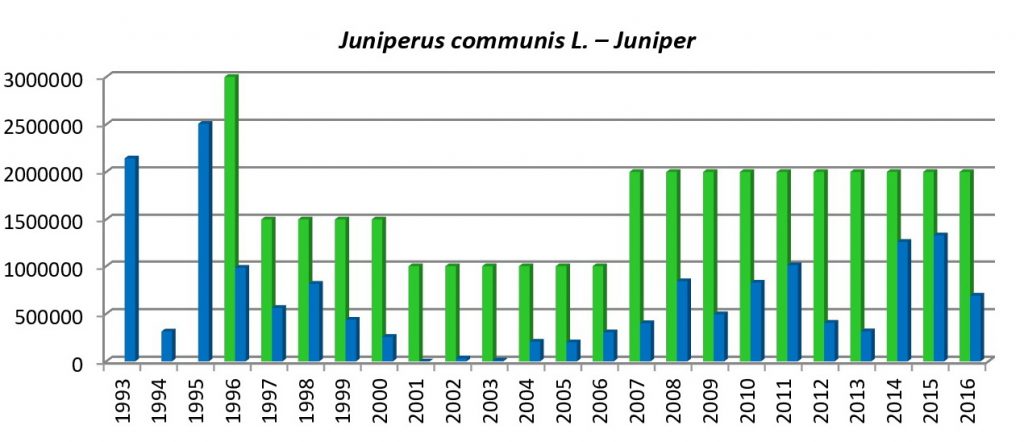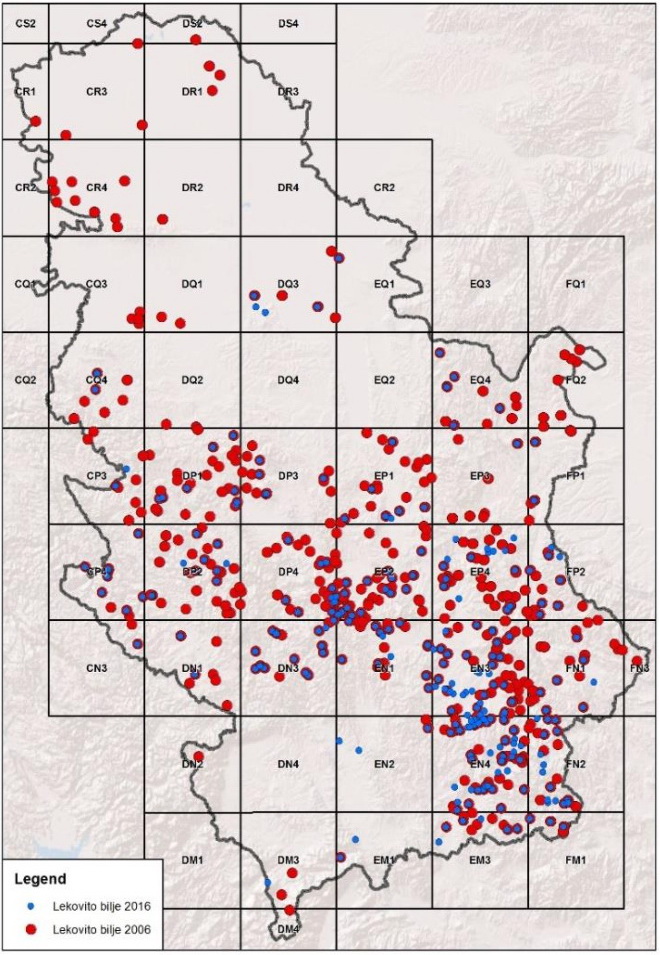Blueberry is the plant species that is most collected in Serbia. Total quantity collected in the period 1993-2016 was 23,599,374 kg, while average collected amount was 983,307 kg annually. Rosehip is the second species in terms of the amount of collection from nature. Thus, with permits, 2,250,060 kg was collected in 2013, 16,960,660 kg was collected in total, while 942,259 kg was annual collected average. Rosehip would have been the most collected plant, but the list of the Regulation on collection control and trade is from 1999, so there is no data for the first 6 years (1993-1998). Juniper is the third type of medicinal plant that are most collected in quantities. Thus, in 1995, permitted collection was 2,500,000 kg of juniper, a total of 16,367,767 kg, while the average annual collection was 681,990 kg.



Subindicator Name: Collection of wild flora – blueberry, juniper, rosehip
Institution/Author: University Futura/dr Radomir Mandić, Environmental Protection Agency/Slaviša Popović
Use and interpretation:
The Indicator shows level of uses of wild flora – blueberry, juniper, rosehip
Key question(s) which indicator helps to answer
What is the level of exploitation of wild flora in Serbia? Are wild flora used in sustainable way?
Use of indicator
In addition to cultivated plant types, overall agro-biodiversity of Serbia also includes wild plant species that represent important components of food production and agriculture (forage crops, medical and aromatic herbs, decorative plants, honey plants, wild fruit). Various agro-ecosystems (arable farms, orchards, vineyards, meadows, pastures, brink and ruderal habitats) and components thereof, also contribute to overall agro-biodiversity of Serbia.
Among genetic resources of medical and aromatic herbs, greatest importance is given to genetic diversity of commercially important species (chamomile, mint, sage, hypericum, yarrow, oregano, bearberry, valerian, plantain, primula, etc.), as well as to sorts of limited areas and to those that are for some reason endangered. Looking at the genetic resources of medical and aromatic herbs and the need for their conservation, coordinated monitoring activity, which would look into the status of their populations, has not been implemented for a long time, while general conservation strategy at national and international levels have not been developed yet.
Scale of appropriate use
The diversity of species that dwell in natural fields (meadows and pastures) has not been well studied or estimated, but number of species within the described 273 plant associations has been estimated at more than 1 000. Total number of medical and aromatic plant species in flora of Serbia is about 700. 280 of these are traded as commodities. Honey plants are primarily found in meadow, forest and agro-ecosystems, and their number in our country has been estimated at approximately 1 800.
Potential for aggregation:
Meaning of upward or downward trends („good or bad“)
The wild relatives are of particular importance as genetic resource in improving and selecting cultivated plants, especially at the level of resistance to various abiotic and biotic stressful external factors. More than a half of cultivated plants have direct relatives within forest and herbaceous plant associations. As far as it is known, there have been no attempts to develop inventory and perform characterization of these genetic resources in our country, except for wild relatives of fruit species.
The collection of medicinal herbs shows upward trends starting from 2004. However, some years are bad for juniper because it does not yield every year, the dry season affects the quantity and quality of medicinal herbs.
Possible reasons for upward or downward trends:
Since 1993, in Serbia, the collection and placing on the market of wild species of plants has been legally regulated, by the Order on putting control of the use and trade of wild plant and animal species (Official Gazette of RS, Nos. 50/93 and 36/94). Today, permits for the collection and trade of wild plants are issued on the basis of the Decree on the Control of the Use and Trade of Wild Flora and Fauna (Official Gazette of RS, Nos. 31/05, 45/05, 22/07, 38/08, 9/09 and 69/11), and the licenses are issued by the Ministry of Environmental Protection, based on the opinion of the Institute for Nature Protection of Serbia.
Implications for biodiversity management of change in the indicator:
By processing the data collected during 24 years, it has been established that the regulations from 1993-2016 included a total of 179 wild medicinal plant species, of which today with the control of collection and trade 63 are included. Analysis of the data for the stated 24-year period, it was established that 50 types of plants from 1993 to 2016 were collected in quantities of more than 10 000 kg per year, depending on the year of collection. Of these, 36 types of plants are still under the control of collection and trade, and 14 species are removed from the list of regulations even though quantities collected are significant.
Units in which it is expressed:
kg per year, number of samples per year
Description of source data:
Ministry of Environmental Protection, Institute for Nature Conservation
Calculation procedure:
By processing the data collected during 24 years, it has been established that the regulations from 1993-2016 included a total of 179 wild medicinal plant species, of which today with the control of collection and trade 63 are included.
Most effective forms of presentation:
(graph types, maps, narratives,etc.-give examples where possible):
The best ways to present this indicator are graphs and tables.
Limits to userfelness and accuracy:
Access to data for analysis
Updating the indicator:
Annually
Closely related indicators
Export of wild flora and fauna
Additional information and comments
